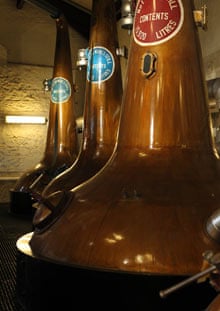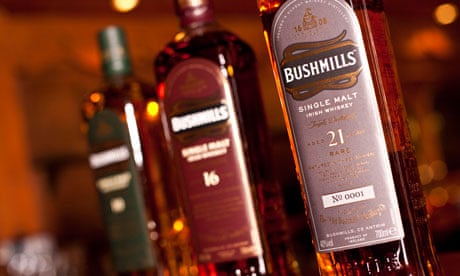Go into any pub this St Patrick's day, and you'd be forgiven for thinking the scourge of Ireland's snakes was born in St James' Gate, so cannily has a certain Dublin brewery leaped on the emerald green bandwagon with shamrock bunting, shameless hats and merchandising. Despite its considerable clout at the pumps, Guinness is not the only stout in the world though – and stout, as pleasing as it is, is emphatically not the only Irish drink worth toasting old Pádraig with, on this or any other day.
If Ireland's cornered the market in beer as black as a boot, Scotland – the likely birthplace of yer man Patrick, as it happens – has established a near monopoly on uisce beatha; they traded a saint for a holy spirit, and seem to have got themselves a bit of a bargain. The scotch whisky market is worth £4bn a year, the Irish one considerably less but, after decades in the doldrums, it is at last rallying: exports were up 30% last year.
The Scots may be the ones making the money, but Ireland has a fair claim on the copyright. The art of distillation is thought to have been introduced to the Emerald Isle by monks after spreading the word of God, and, with abundant supplies of barley, water and peat to power the stills, they were on to a winner – with the whiskey at least. There was certainly a distillery in County Westmeath by the 12th century: the first record of whisky production across the water in Fife doesn't appear until 1494 (although given it's a receipt for enough malt to produce 1,500 bottles, it seems unlikely this was the purchaser's first foray into the market).

For much of its history Irish whiskey was regarded as the superior spirit – Elizabeth I certainly seems to have appreciated it, if shipping documents serve correct – and by the end of the 18th century, there are thought to have been 2,000 distilleries in Ireland; one for every 2,000 people. Most were probably tin pot affairs, but the industry was still perfectly placed to take advantage of the phylloxera epidemic that devastated European vineyards in the mid-19th century. With the world's brandy drinkers left thirsty, the Victorian period was a boom time for Irish whiskey, which enjoyed a huge export trade around the Empire: tea was planted, sheep tended and the local workforce subdued with the help of Jameson and its ilk.
Perhaps inevitably, the infamous luck of the Irish eventually caught up with their whiskey industry. It was a Dublin man, Aeneas Coffey, who perfected the design of the modern continuous still, making distillation cheaper and more efficient. Local distillers pooh-poohed his idea, so he took his invention over to Scotland, where they seized upon its money-making potential immediately, enabling them to embark upon grain whisky production and to finally beat the Irish at their own game.
A century or so later, while the Irish were still hanging stubbornly on to their old-fashioned pot stills, there came the double whammy of prohibition – which effectively shut down one of their biggest markets – and independence, which prompted the British to slap a great big import tax on their product. As for the GIs who developed a taste for scotch while stationed in Britain during the war, well, by that point it hardly mattered. By the 1970s there was just one distilling business left on the entire island of Ireland.
Thanks to new boy Cooley, the country's only independent distillery (and, indeed, the only one in Irish ownership) which appeared in 1987, as well as the more recent sale of Bushmills to drinks giant Diageo, there are now three distillers active there. Scotland, meanwhile, has over 100.
But despite what the sales figures may say, and whatever your take on the history, sweet and ever so subtle, Irish whiskey is worth drinking for itself. One word you'll hear a lot in any distillery there is "smooth". It seems to have become the industry's USP, and it's a fair observation: the vast majority of the output is triple, rather than double distilled, as most scotches are (although, as buffs are always keen to point out, there are exceptions in both cases), a process which helps to rub off those fiery edges and gives a lighter, cleaner final spirit. If you're a fan of big-hitting Islay whiskies you may struggle to recognise the more subtle Irish version, but Bushmill's 10 year old, a remarkable delicate, apple-scented, subtly spiced single malt which master blender Helen Mulholland describes as "the backbone of everything we do here", is the perfect example of the difference between the two spirits.
However, although they now have some outstandingly subtle single malts to choose from, traditionally the Irish favour more boisterous blends of malted and unmalted barley from the round-bellied copper pot stills which once ruled every distillery on both sides of the Irish Sea. Very few 100% pot still whiskies are now made – but Redbreast and Green Spot are notable examples, and well worth a try if you can track them down (some Waitrose shops, and London's Berry Bros & Rudd have Redbreast). The latter, distilled in Cork for Dublin wine merchants Mitchell & Son, is particularly elusive – try online – but all the better for it: whisky writer Jim Murray has described it as a "beautifully preserved, almost living throwback to the old Ireland."
In its eagerness to catch up its old rival, Ireland even produces a peated whiskey these days – Connemara, produced by Cooley, gives the lie to the idea that Islay has the monopoly on smoke, although the sweet, slightly grassy undertones give it a distinctively Irish personality you wouldn't mistake in a month of Sundays.
As we sniff some of Bushmill's unpeated barley, grown in Co Cork, Helen suggests that the Irish triple distil their whiskey because "we're always looking for a smoother, clearer flavour". When I ask why she shrugs – "we just like it that way. You'll tend to find we do a lot of things just because we like them – many of them make no sense otherwise!"

The same individualist sentiment could be applied to the master blender's own "baby", the Bushmills 1608, a special bottling created to celebrate the 400th anniversary of the distillery licence, which is a decadent riot of dark chocolate, mixed peel and sweet spice. Cocoa is also a feature of the distillery's acclaimed 16-year-old, finished in three different woods (described by Whisky Magazine as boasting "seismic waves of spicy fruit") and the satin-smooth 21-year old, which has a distinctly After Eight-like finish. "Other blenders always say they can taste my blends" Helen smiles.
This sense of playfulness is one of my favourite things about Irish whiskey. Because the flavours tend to be cleaner, it seems to work better in cocktails than scotch as well – Colum Egan, Bushmills' master distiller, likes to drink their feisty Black Bush blend with ginger ale, and Helen favours it with lemon and lime, but I think, after prolonged experimentation, it makes a pretty incredible Old Fashioned.
Alternatively, of course, you can celebrate St Patrick's Day, US-style, with the utterly revolting sounding "Everybody's Irish" – whiskey, crème de menthe and green Chartreuse, garnished with a green olive. But if you're going to do that, you may as well buy a Guinness hat and stick the Pogues on while you're at it.

Comments (…)
Sign in or create your Guardian account to join the discussion